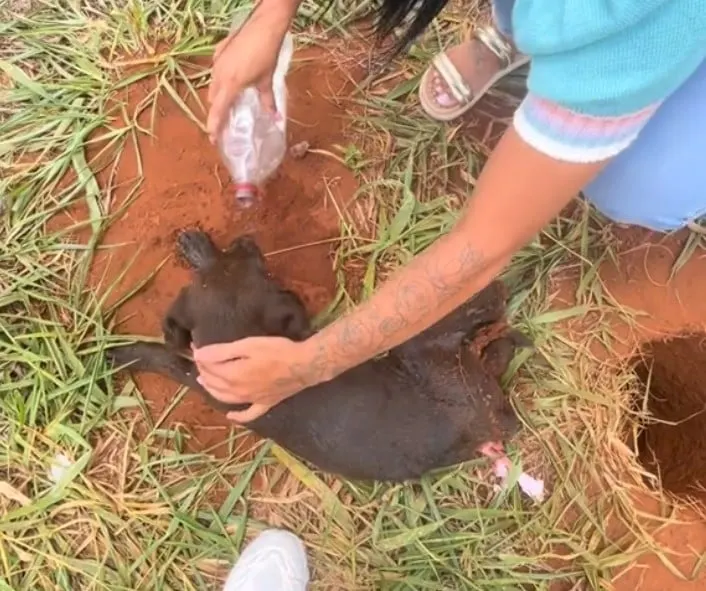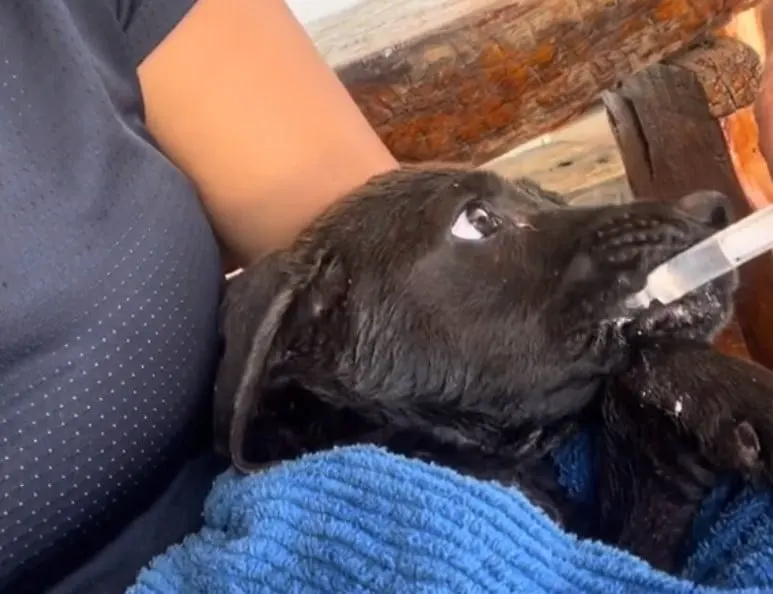While walking home from school, taking the same route, one boy heard something very unusual and alarming.
It was coming from a construction site, and it sounded like a dog who desperately needed help.
Rescue Mission

Since the dog was nowhere to be seen, the boy decided to look for him. At first, he had no luck in finding him, but the boy didn’t give up.
He started following the cries, which eventually brought him to the pup who had gotten himself in a very sticky situation.

The boy knew he needed some help, so he alerted his sister, Karlo, who dropped everything she was doing and rushed to help the poor pup.
First, she sprayed the dog with water as well as reassured him that she was only trying to help.
Then, when she gained the dog’s trust, she carefully lifted him out of a hole.

Since he had likely spent a long time in the hole, the pup was so exhausted and weak that he couldn’t stand up on his paws.
As he was lying on the ground, Karlo sprayed him with water again, trying to cool him down and clean him up.
Karlo then decided that they couldn’t just leave the pup there so she told her brother to carry the pup home.
They also captured the whole rescue and posted it on TikTok, where it soon went viral.
At The Vet
Karlo then gave the pup a nice bath to get him nice and clean before taking him to the vet.
At the vet, the pup got a very thorough checkup as well as some nutritious food that would help him get his strength back.

They also found out that this pup wasn’t a stray, as they had initially thought. Rather, he had an owner who was living close by.
Karlo went to the owners, telling them about the pup’s little accident and informing them that he would be staying at the vet until he started feeling better.
The owner told them that the dog, named Doguinho, also has a little family that is worried and is waiting for him to come back home.

Final Word
Even though Doguinho was in safe hands now, Karlo simply couldn’t forget about him.
She continued to visit him at the vet, and also kept in contact with his owner, offering him help with not just Doguinho, but all of the other dogs he was taking care of.
I am sure that the brave little pup will recover in no time and will finally be reunited with his adorable little family.
Ever noticed how your furry companion’s tail seems to have a mind of its own? It’s a familiar sight – that joyful wag that can instantly lift your spirits. But have you ever stopped to wonder what’s really behind this tail-wagging behavior? As a seasoned dog enthusiast, you’ve likely pondered this question more than once.
When your canine friend starts wagging its tail, it’s like a silent language that speaks volumes. The tail becomes a wagging indicator, conveying a range of emotions without uttering a single bark. Understanding the nuances of why dogs wag their tails can offer fascinating insights into their world of communication and connection. So, let’s take a closer look at this tail-telling phenomenon and unravel the mysteries behind your dog’s wagging tail.
Understanding Dog Communication
The Language of Tail Wagging
When it comes to dogs, tail wagging isn’t just a random movement – it’s their way of communicating with you and other dogs. A wagging tail can express various emotions and messages, from joy and excitement to anxiety and insecurity. Understanding the nuances of your dog’s tail wag can give you valuable insights into what they’re feeling at that moment.
Body Language Beyond the Tail
While the tail is a significant part of a dog’s communication repertoire, their whole body also plays a crucial role in expressing emotions. Dogs convey a wealth of information through their body language, including their posture, facial expressions, and vocalizations. Paying attention to these cues alongside tail wagging can help you better grasp your furry friend’s thoughts and feelings.
The Science Behind Tail Wagging
Emotional Responses and Tail Movement
When a dog wags its tail, it’s not just a random movement; it’s a key piece of their communication puzzle. Dogs wag their tails to convey emotions. A fast wag often means excitement or happiness, while a slow wag might signal wariness or insecurity. Pay attention to the speed and direction of the wag to get a glimpse into your furry friend’s mood.
The Role of Tail Wagging in Social Interaction
Tail wagging serves as a social tool for dogs. It’s their way of reaching out to other dogs and humans, expressing their intentions. Dogs use tail wagging to greet, show submission, or even to warn others. Understanding the context of the wag can help you interpret your dog’s social interactions and enhance your bond with them.
Interpreting Tail Wags
Signs of Happiness and Excitement
When your dog wags its tail with wide, sweeping motions and a relaxed body posture, it’s likely feeling happy and excited. You may notice a cheerful expression in its eyes and a playful demeanor. Tail wagging in this context is a positive sign of your dog’s joy and eagerness to interact with you or other animals.
Indicators of Fear or Submission
A dog wagging its tail with a low or tucked position, along with tense body language and ears pressed back, could indicate fear or submission. This type of tail wagging is often slow and accompanied by other signals of discomfort or anxiety. Understanding these cues can help you recognize when your dog is feeling uneasy or insecure.
Aggression and Alertness Cues
A dog displaying short, rapid tail wags with a stiff body, raised fur, and a fixed gaze may be showing signs of aggression or alertness. This type of tail movement can signal a readiness to defend or react to a perceived threat. It’s important to be cautious and attentive when observing these behaviors to prevent potential conflicts or misunderstandings with your dog.
Remember, interpreting your dog’s tail wags is just one aspect of understanding its emotions and intentions. By paying attention to the context, body language, and overall behavior, you can deepen your bond with your furry companion and ensure a harmonious relationship based on mutual trust and communication.
Factors Affecting Tail Wagging
Breed and Tail Structure Differences
Different dog breeds have varying tail structures, affecting how they wag their tails. For instance, dogs with long tails, such as Golden Retrievers, have more pronounced and visible tail movements compared to breeds with naturally docked tails like Boxers. The length, shape, and the way a dog’s tail is set can influence the range of motion and style of wagging. Understanding these breed-specific differences can help you interpret your dog’s tail language accurately.
The Influence of Environment and Experience
A dog’s environment and past experiences play a significant role in how it wags its tail. Dogs that have been socialized in positive environments tend to wag their tails more freely and joyfully, reflecting their confidence and happiness. On the other hand, dogs that have faced trauma or negative experiences may exhibit more reserved or cautious tail wagging. By considering the impact of environment and past interactions, you can better comprehend your dog’s emotional state through its tail movements.
Tail Wagging in Domestic vs. Wild Canines
Comparing Domestic Dogs to Their Wild Relatives
Domestic dogs and their wild counterparts exhibit differences in tail wagging behavior. While domestic dogs often wag their tails as a form of joyful expression or social interaction with humans and other animals, wild canines such as wolves primarily use tail wagging for communication within their packs. Domestic dogs have adapted their tail wagging to communicate with humans based on their unique bond with people, while wild canines use tail movements to convey social hierarchy, submission, or assert dominance in their natural habitats. Understanding these distinctions can help you interpret your dog’s emotions more accurately and strengthen your relationship with them.
The Evolution of Tail Wagging
The evolution of tail wagging in dogs traces back to their ancestral roots and survival instincts. Wild canines developed tail wagging as a vital form of communication to maintain order within their packs, establish dominance, express submission, or signal aggression during hunting or territorial disputes. Over time, domestication has influenced how dogs wag their tails, shifting the focus towards communicating with humans and other domestic animals. This evolution has adapted tail wagging to convey a broader range of emotions and messages beyond survival instincts, reflecting the unique relationship between dogs and humans. By recognizing the evolutionary origins of tail wagging, you can better understand your dog’s behavior and strengthen the connection between you and your furry companion.
Conclusion
So, there you have it! Tail wagging in dogs is more than just a cute gesture; it’s their way of speaking to you without words. From conveying excitement to showing trust, your furry friend’s tail is a window into their emotions. Breed differences, past experiences, and even ancestral instincts all play a role in how and why dogs wag their tails. By understanding these subtle cues, you can deepen your bond with your canine companion and build a stronger relationship based on clear communication. So, next time your dog wags its tail, remember that it’s not just wagging; it’s speaking to you in its own special way.
Frequently Asked Questions
What does a dog’s tail wagging signify?
A dog’s tail wagging is a form of communication expressing various emotions like happiness, excitement, and even anxiety.
Are there differences in tail wagging behavior among dog breeds?
Yes, different dog breeds may have variations in their tail wagging patterns based on their genetic makeup and breed characteristics.
How can a dog’s past experiences affect its tail wagging?
A dog’s past experiences, such as positive or negative interactions, can influence their tail wagging behavior and the emotions they convey.
Do wild canines use tail wagging similarly to domestic dogs?
Wild canines, like wolves, primarily use tail wagging for pack communication and signaling social hierarchy, unlike domestic dogs that have adapted it for human communication.
What is the evolutionary significance of tail wagging in canines?
Tail wagging has evolved from ancestral roots as a survival instinct in wild canines to a broader emotional communication tool in domestic dogs due to the process of domestication.
[no_toc]

Hey there, I’m Janet Brooks, a dog-loving student from California. I’m all about helping pups in need, especially those without homes. Me and my awesome friends work together to give shelter and love to stray dogs. Oh, and I also write blogs about dogs to share helpful info.